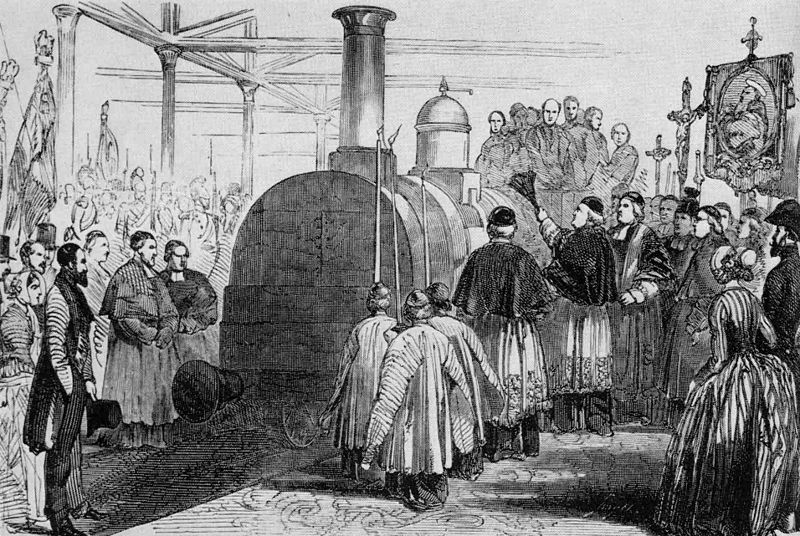 Bibliography (in French): Library of Rouen.
Bibliography (in French): Library of Rouen. 
Daniel (following a visit to Pissy-Poville cemetery where he found the graves of some British engineers) found out about the new railways in France - and how the new line from Paris to Rouen and Le Havre was constructed.
The engravings in this article show the inauguration of the line in 1847, and a general view of a train
Consequently prices in transport and delivery delays increased. A crisis happened because the demand was higher and higher.
At that moment France was aware of and curious about the British achievements in a new kind of transport. England was in advance on railway construction. In 1804 a steam machine was already on trial in England. Research in this way of transporting had been done since the 1820's. It was the beginning of the British trains.
In 1818 Mr Gallois, a French engineer from St Etienne in the department of the Loire spent 16 months in England, to study the British steel industry. When he came back to France he presented a report on Stephenson's locomotives.
He built the first railway track between Andrézieux and St Etienne to carry coal from mines. It opened on October 1, 1828, with wagons pulled by horses. Steam traction happened there only in 1844.
In 1842 two railway lines were opened in France: from Paris to St Germain en Laye and from Versailles to the right bank of the Seine.
The tracks were built on the British model; the gauge (i.e. the width between the rails) was and still is 1.435 meters, that is to say exactly 4 feet and 8 and a half inches. Why this size? Because France copied the British know-how. The gauge as mentioned above, was that of horse carriages. It was a question of stability between length and width. It was then easier to transform carts into wagons.
The first line opened to public in England in 1825 was about seven miles long, between Stockton on Tees and Darlington in Northumberland (i.e. in North East England).
On the two French lines opened in 1842 there were 44 locos of the type called Patentee. 30 were British and 14 French. They had three axles and were all reproductions of the English steam model developed by Robert Stephenson, a mechanical engineer.
The French understood that the train was a way to modernity. It's why the French government passed the law of June 11, 1842 which organised the construction and the development of the railroad everywhere in France. A second reason was that the British were interested in easier relations between Paris and London.
In June 1840 the construction from Paris to Rouen was decided. Laffitte and Blount, a French and British company was created, with a capital of 36 million francs. 50 % was French and 50 % British. Laffitte and Blount were both bankers, the first was French and the second British, and they worked in London.
The town of Rouen invested the huge sum of 1 300 000 francs. A 14 million state loan was granted to the company. The line was completed between Paris and Rouen in May 1843 and the first train arrived in Rouen on May 3, 1843. The speed of the trains was planned to be between 30 and 40 km per hour.
On the May 9, 1843 the commercial service began, linking the two stations in 3 hours and 50 minutes.
What was a Franc of 1840 worth in Euros? Wikipedia responds 8.17 € in 2007; therefore 36 000 000 Francs are about 294 120 000 €. A pound is worth about 1.4 €. In pounds the capital is approximately £ 210 085 715.
In 1846 a 1st class mason earned 3 Francs a day for 10 hours’ work.
A second class mason earned 2.5 Fr, a miner 2.7 Fr, a digger 2 Fr, and an ordinary laborer 1.5 Fr.
As for prices, one kg of bread was 0,25 Fr, one kg of potatoes 0,08 Fr, one kg of pork 1 Fr, and a litre wine 0.10 Fr.
As early as 1843 it was decided to build the line from Rouen to Le Havre but problems appeared. The valleys of Cailly and Austreberthe had to be crossed. 2 viaducts were necessary in Malaunay and Barentin and a 2200 meter tunnel between Malaunay and Pissy Pôville.
The management of works was entrusted to Joseph Locke a British engineer (1805-1860). Tunnels and bridges were under the responsibility of the British enterprise Mackenzie and Brassey.
Another British company Alcard & Buddicum made the rolling stock to operate the line, with 500 workers in Rouen. The first order was for 40 locomotives, 120 cars for passengers and 200 wagons for goods.
The new line opened on March 20, 1847.
 Bibliography (in French): Library of Rouen.
Bibliography (in French): Library of Rouen.